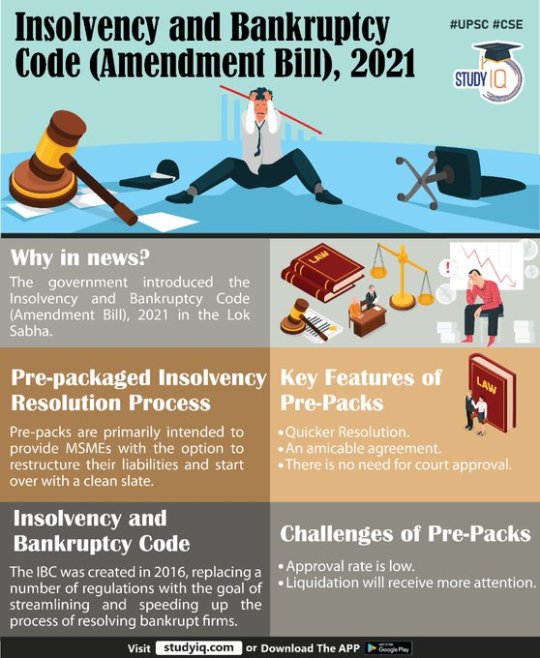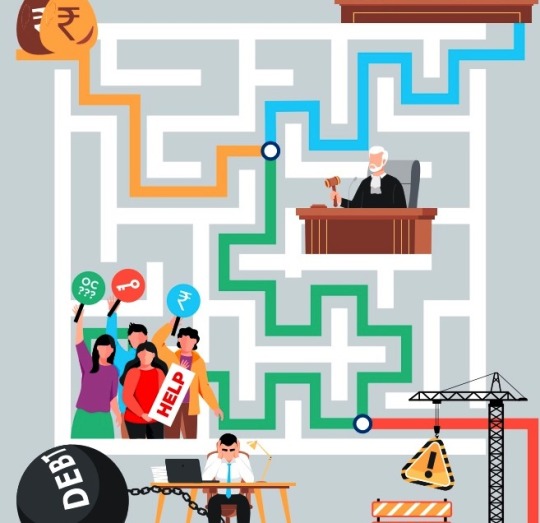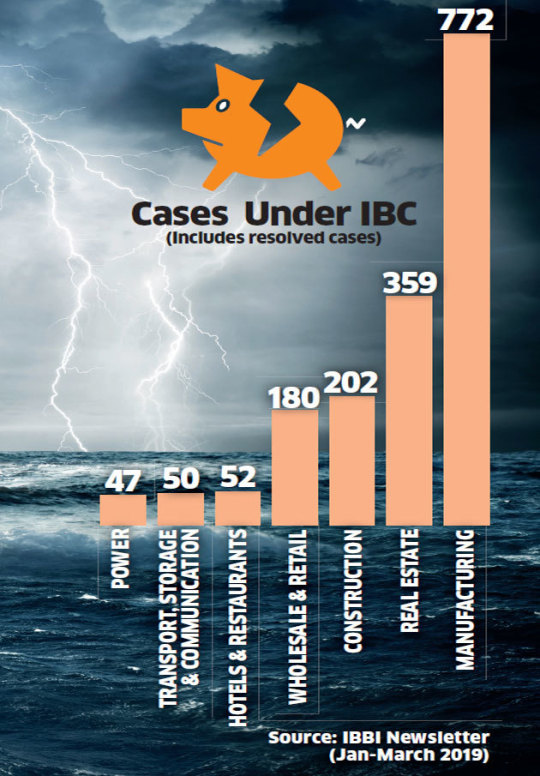#BankruptcyCode
Explore tagged Tumblr posts
Text
Debt Recovery Under IBC

Debt recovery is a legal process begun by creditors to collect unpaid debts from individuals or businesses. The Insolvency and Bankruptcy Code (IBC) of 2016 offers India a methodical framework for managing insolvency and bankruptcy issues, guaranteeing efficient debt resolution and so protection of the interests of all those engaged.
What is Debt Recovery?
Debt recovery is the legal process that is initiated by the creditor for the accumulation of unpaid debts from individuals or businesses who are in breach of obligation on their financial outstanding debts, which can include issuing demand letters, arranging payment terms, filing a lawsuit via courts or Debt Recovery Tribunals (DRTs), and, if needed, executing security rights to get back the outstanding debt.
Insolvency and Bankruptcy Code,2016
The Insolvency and Bankruptcy Code, 2015, was referred to the Joint Committee following its introduction in the Lok Sabha on December 21, 2015. On such a referral, the Committee had submitted its recommendations and a revised Bill that was derived from its suggestions. The Insolvency and Bankruptcy Code, 2016, was enacted by both Houses of Parliament in May 2016. The primary goal of these economic reforms is to concentrate on the resolution of insolvency that is driven by creditors.
Features of Insolvency and Bankruptcy code,2016
The Insolvency and Bankruptcy Code (IBC), 2016, is a comprehensive legal framework aimed at addressing insolvency and bankruptcy issues in India, providing a structured process for the resolution of financial distress. Here are the key features of the IBC:
IBC delivers a holistic approach for handling financial distress, pertinent to companies, individuals, and partnership firms. The code established clear protocols for launching an insolvency procedure, enabling both creditors and debtors to take initiative. It is important to note that the insolvency resolution process is completed within strict deadlines, which facilitates the efficient and expeditious resolution of distressed assets.
The Insolvency and Bankruptcy Board of India (IBBI) affirms the commitment to proper monitoring and debt resolution procedures. The IBBI is instrumental in the standardization of practices and the enforcement of the IBC's provisions, as it is represented by key stakeholders such as the government, RBI, and legal specialists.
The IBC introduced the concept of licensed insolvency professionals (IPs) who are responsible for the management of insolvency proceedings. These professionals contribute impartiality and expertise to the resolution process, thereby enabling transparent and equitable outcomes. The accountability and credibility of the resolution process are improved by their oversight of debtor assets during insolvency proceedings.
The IBC establishes specialized tribunals, the National Company Law Tribunal (NCLT) and the Debt Recovery Tribunal (DRT), to effectively adjudicate insolvency matters. These tribunals offer specialized forums for the resolution of insolvency cases involving companies, individuals, and partnership firms, thereby guaranteeing the prompt and impartial resolution of disputes.
The insolvency resolution procedure is streamlined by the IBC, which offers a clear roadmap for the initiation and processing of insolvency petitions. The appointment of Insolvency Resolution Professionals (IRPs) to draft resolution plans and the prohibition of company directors during the resolution period are among the key highlights. Furthermore, provisions for liquidation guarantee a methodical approach to the liquidation of insolvent entities, thereby protecting the interests of creditors.
The IBC includes provisions that prevent defaulters and disqualified individuals from participating in the resolution process, thereby fostering accountability and integrity. The transparency and impartiality of the liquidation process are further bolstered by the prohibition of the sale of defaulter's property to disqualified individuals. The objective of these amendments is to prevent potential violations of the insolvency framework and to increase creditor confidence.
Objectives of the Code
The Insolvency and Bankruptcy Code, 2016 (IBC) was enacted to create a streamlined and time-bound process for resolving insolvency and bankruptcy issues in India. The key objectives of the IBC are:
Ensuring that distressed assets are resolved efficiently to preserve their value and minimize losses.
Providing a structured process with strict timelines for corporate insolvency resolution (CIRP) to avoid unnecessary delays.
Encouraging businesses by offering a smooth exit mechanism for failing ventures and reducing the fear of failure.
Prioritizing the interests of creditors, especially financial creditors, by giving them control over the resolution process.
Protecting the rights of all stakeholders, including creditors, employees, and investors.
Strengthening India’s business environment by reducing risks associated with credit defaults.
Providing an effective framework to deal with bad loans and stressed assets in the banking system.
Encouraging resolution over liquidation to help businesses recover rather than shutting them down.
Replacing multiple, outdated laws (such as SICA, SARFAESI, Companies Act provisions) with a unified insolvency framework.
Enhancing investor confidence by offering a predictable and transparent insolvency resolution process.
Procedure Under the Code
In case the pending recovery amount is ₹1 crore or more, the creditor can commence the resolution process by lodging an application before the National Company Law Tribunal (NCLT). Upon approval being granted, an Interim Insolvency Professional (IRP) is given the responsibility to manage the process. The IRP oversees the debtor’s assets and disclosed financial information to creditors. This phase persists for 180 days, during which legal proceedings against the debtor are restricted.
IRP is liable to form a Committee of Creditors (CoC) that consists of financial creditors. The committee determines whether to reform the debt via a modified payment schedule or liquidate the debtor's holdings to collect outstanding payments.
If no settlement is reached within 180 days, or if revival is not viable, the debtor’s assets will be subjected to liquidation. A liquidator is designated to evaluate the value of assets and disperse the distributed proceeds to creditors in accordance with the priority order specified in the Code.
Conclusion
The 2016 Insolvency and Bankruptcy Code (IBC) offers a disciplined, time-bound framework for handling debt collection issues and insolvency. The IBC improves India's economic environment and provides a clear way to handle troubled assets by giving creditor interests first priority and pushing settlement above liquidation.
0 notes
Text

#Insolvency and#Bankruptcy Code (#Amendment Bill)#2021#bankruptcycode#amendmentbill2021#upsc#cse#whyinnews
0 notes
Text
IBC delivers superior value to creditors in real estate

According to a joint report by property consultants ANAROCK and leading law firm, Khaitan & Co, Insolvency & Bankruptcy Code (IBC) has resulted in settlement of 66% of the admitted claims in real estate sector in comparison to just 31% of admitted claims realised in other sectors. Real estate consumers have very important avenue for relief in the form of IBC through which real estate cases are admitted in National Company Law Tribunal (NCLT). An important milestone in the evolution of IBC has been the amendment that gives homebuyers the status of financial creditors. Hence, the homebuyers are considered at par with banks and other institutional creditors -- when it comes to recovering dues from those builders who have gone bankrupt. According to Shobhit Agarwal, MD & CEO, ANAROCK Capital, IBC code has been helping the lenders in securing their dues in a much quicker timespan, it has delivered superior value realisation to the stakeholders of real estate sector compared to other industries. Successfully resolving insolvencies and driving value realisation through this code requires adequate planning and a structured approach. He added that real estate has the highest proportion of ongoing cases under Corporate Insolvency Resolution Process (CIRP), Aashiesh Agarwaal, SVP - Research & Investment Advisory, ANAROCK Capital, observed that the report examines the progress made on marquee cases involving real estate developers, including Unitech Ltd., Ariisto Developers, Supertech Read the full article
0 notes
Link
#insolvency professional#insolvency and bankruptcy code#insolvency bankruptcy#insolvency bankruptcycode
0 notes
Link
Many people think that insolvency and bankruptcy have the same meaning, but they are very dissimilar. Read this blog to know what exactly both the terms are and how do they affect the Indian industries.
#bankruptcy#bankruptcycode#India#Indianindustries#finance#companies#investment#IBC#cicaAct#business#KnowYourRights#justiceforall#taxolawgy
0 notes
Link
Visit our website to read more info on bankruptcy code: http://bankruptcy.coretips.com/bankruptcy-code.php
0 notes
Text
Why resolution process is virtually impossible under the Insolvency and Bankruptcy Code
Why resolution process is virtually impossible under the #Insolvency and #BankruptcyCode

On Dr Dadabhai Naoroji Road in Mumbai’s Fort business district, barely 300 metres from the National Company Law Tribunal (NCLT) courts in Mumbai, sits Kini House, the offices of the law firm MV Kini & Company. Its entrance is easy to miss, with an array of shops on the ground floor selling cheap electronic gadgets and knick-knacks.
The facade is partially hidden by construction paraphernalia of…
View On WordPress
0 notes
Video
youtube
Introduction To Insolvency and Bankruptcy Code 2016 | CA Ritesh Mittal |...
0 notes
Photo

The RBI is beginning to bare its fangs
https://wp.me/p9Hiic-c1b #AssetClassification, #BadLoans, #BankruptcyCode, #NPAs, #NSVishwanathan, #RBI, #StressedAssets, #UrjitPatel
#asset classification#bad loans#bankruptcy code#NPAs#NS Vishwanathan#RBI#stressed assets#Urjit Patel
0 notes
Text
Insolvency and Bankruptcy Code spurs M&A activity
#Insolvency and #BankruptcyCode spurs #M&A activity
Acquisition of distressed assets has gone up in India since the implementation of the Insolvency and Bankruptcy Code. According to a report by Bain & Company, these acquisitions have accounted for 70% growth in deal value in 2018, compared to a year ago. The period between January 2015 and April 2019 has seen seven large distressed assets acquisitions, amounting to $23 billion (around Rs 1.62…
View On WordPress
0 notes
Text
Changes in Insolvency and Bankruptcy Code may increase burden on IRPs
Changes in #Insolvency and #BankruptcyCode may increase burden on #IRPs
Changes put in place by the Insolvency and Bankruptcy Board of India (IBBI), to ensure credibility of the debt resolution process, could increase the burden on insolvency resolution professionals (IRPs), experts have said.
On Tuesday, the IBBI said it has amended its regulations to ensure that lenders take into account the background, credit worthiness and credibility of bidders, including…
View On WordPress
0 notes
Text
Keep homebuyer, lender rights on par under Insolvency and Bankruptcy Code: SBI MD
Keep homebuyer, lender rights on par under #Insolvency and #BankruptcyCode: SBI MD
The country’s largest lender State Bank of India believes that rights of homebuyers and lenders of stalled realty projects of developers being dealt under the Insolvency and Bankruptcy Code need to be kept on a par.
“Both lenders and homebuyers will have to bear losses in bankruptcy cases on pari passu basis; only one player cannot take losses. Both homebuyers and lenders need to be kept on equal…
View On WordPress
0 notes
Text
How the bankruptcy code can be abused by unscrupulous elements
How the #BankruptcyCode can be abused by unscrupulous elements
When a little-known company Shiv Sneha Associates advertised that it would file bankruptcy proceedings against the NYSE-listed MakeMyTrip, valued at $3 billion, to recover its dues, it showed how a new law can become a tool to intimidate businesses.
A number of frivolous petitions at the National Company Law Tribunal (NCLT), which administers the Insolvency and Bankruptcy Code (IBC), is a cause…
View On WordPress
0 notes
Text
The new Insolvency and Bankruptcy Code will make it impossible for Indian banks to lend with compassion
The new #Insolvency and #BankruptcyCode will make it impossible for #Indian banks to lend with compassion
When the Reserve Bank of India dropped a bombshell on the evening of June 13, ordering banks to take the top-12 defaulters to bankruptcy courts, it also laid the foundation for changing the way Indian banks engage with big business families hereon.
A week after the regulatory whiplash, bankers have buried the hopes of business as usual. While they are working out strategies to emerge from the…
View On WordPress
0 notes
Text
Mergers and acquisitions under Bankruptcy Code: some concerns
#Mergers and #acquisitions under #BankruptcyCode: some concerns
By encouraging a transparent and time-bound sale of assets and businesses of defaulting corporate debtors, the Insolvency and Bankruptcy Code, 2016 (Bankruptcy Code) promises a fillip in merger and acquisition (M&A) trades. This has been furthered by recent policy changes e.g., Securities and Exchange Board of India or Sebi’s announcement exempting issuance of shares by distressed listed…
View On WordPress
0 notes